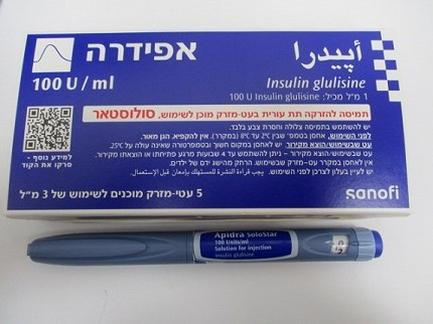Quest for the right Drug

אפידרה APIDRA (INSULIN GLULISINE)
תרופה במרשם
תרופה בסל
נרקוטיקה
ציטוטוקסיקה
צורת מתן:
תת-עורי : S.C
צורת מינון:
תמיסה להזרקה : SOLUTION FOR INJECTION
עלון לרופא
מינוניםPosology התוויות
Indications תופעות לוואי
Adverse reactions התוויות נגד
Contraindications אינטראקציות
Interactions מינון יתר
Overdose הריון/הנקה
Pregnancy & Lactation אוכלוסיות מיוחדות
Special populations תכונות פרמקולוגיות
Pharmacological properties מידע רוקחי
Pharmaceutical particulars אזהרת שימוש
Special Warning עלון לרופא
Physicians Leaflet
Posology : מינונים
4.2 Posology and method of administration Posology The potency of this preparation is stated in units. These units are exclusive to Apidra and are not the same as IU or the units used to express the potency of other insulin analogues (see section 5.1). Apidra should be used in regimens that include an intermediate or long acting insulin or basal insulin analogue and can be used with oral hypoglycaemic agents. The dose of Apidra should be individually adjusted. Special populations Renal impairment The pharmacokinetic properties of insulin glulisine are generally maintained in patients with renal impairment. However, insulin requirements may be reduced in the presence of renal impairment (see section 5.2). Hepatic impairment The pharmacokinetic properties of insulin glulisine have not been investigated in patients with decreased liver function. In patients with hepatic impairment, insulin requirements may be diminished due to reduced capacity for gluconeogenesis and reduced insulin metabolism. Elderly Limited pharmacokinetic data are available in elderly patients with diabetes mellitus. Deterioration of renal function may lead to a decrease in insulin requirements. Pediatric population There is insufficient clinical information on the use of Apidra in children younger than the age of 6 years. Method of administration Apidra 100 Units/ml solution for injection in a vial Continuous subcutaneous insulin infusion Apidra may be used for Continuous Subcutaneous Insulin Infusion (CSII) in pump systems suitable for insulin infusion with the appropriate catheters and reservoirs. Patients using CSII should be comprehensively instructed on the use of the pump system. The infusion set and reservoir used with Apidra must be changed at least every 48 hours using aseptic technique. These instructions may differ from general pump manual instructions. It is important that patients follow the Apidra specific instructions when using Apidra. Failure to follow Apidra specific instructions may lead to serious adverse events. When used with a subcutaneous insulin infusion pump, Apidra must not be mixed with diluents or any other insulin. Patients administering Apidra by CSII must have an alternative insulin delivery system available in case of pump system failure (see sections 4.4 and 4.8). Apidra 100 Units/ml solution for injection in a vial For further details on handling, see section 6.6 Apidra 100 Units/ml solution for injection in a pre-filled pen SoloStar Apidra 100 Units/ml in pre-filled pen SoloStar is only suitable for subcutaneous injections. If administration by syringe or infusion pump is necessary, a vial should be used (see section 4.4). For further details on handling, see section 6.6. Subcutaneous use Apidra should be given by subcutaneous injection shortly (0-15 min) before or soon after meals or by continuous subcutaneous pump Infusion . Apidra should be administered subcutaneously in the abdominal wall, thigh or deltoid or by continuous infusion in the abdominal wall. Injection sites and infusion sites within an injection area (abdomen, thigh or deltoid) should be rotated from one injection to the next in order to reduce the risk of lipodystrophy and cutaneous amyloidosis (see section 4.4 and 4.8). The rate of absorption, and consequently the onset and duration of action, may be affected by the injection site, exercise and other variables. Subcutaneous injection in the abdominal wall ensures a slightly faster absorption than other injection sites (see section 5.2). Care should be taken to ensure that a blood vessel has not been entered. After injection, the site of injection should not be massaged. Patients must be educated to use proper injection techniques. Mixing with insulins When administered as a subcutaneous injection, Apidra must not be mixed with other medicinal products except NPH human insulin. For further details on handling, see section 6.6. Before using SoloStar, the instructions for use included in the package leaflet must be read carefully (see section 6.6).

פרטי מסגרת הכללה בסל
התרופה האמורה תינתן לטיפול בחולי סוכרת.
מסגרת הכללה בסל
התוויות הכלולות במסגרת הסל
| התוויה | תאריך הכללה | תחום קליני | Class Effect | מצב מחלה |
|---|---|---|---|---|
| התרופה האמורה תינתן לטיפול בחולי סוכרת. | 15/05/2006 | מחלות מטבוליות |
שימוש לפי פנקס קופ''ח כללית 1994
לא צוין
תאריך הכללה מקורי בסל
15/05/2006
הגבלות
תרופה מוגבלת לרישום ע'י רופא מומחה או הגבלה אחרת
מידע נוסף
עלון מידע לרופא
17.01.21 - עלון לרופאעלון מידע לצרכן
17.08.21 - עלון לצרכן 02.11.20 - עלון לצרכן 02.11.20 - עלון לצרכן 02.11.20 - עלון לצרכן 02.11.20 - עלון לצרכן 13.07.21 - עלון לצרכן אנגלית 17.08.21 - עלון לצרכן אנגלית 13.07.21 - עלון לצרכן עברית 17.08.21 - עלון לצרכן עברית 13.07.21 - עלון לצרכן ערבית 17.08.21 - עלון לצרכן ערבית 28.11.11 - החמרה לעלון 21.08.13 - החמרה לעלון 01.07.14 - החמרה לעלון 17.05.20 - החמרה לעלון 17.01.21 - החמרה לעלוןלתרופה במאגר משרד הבריאות
אפידרה